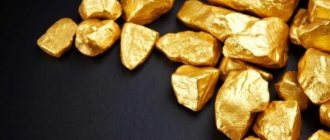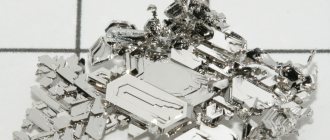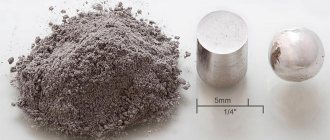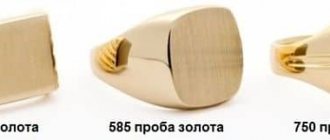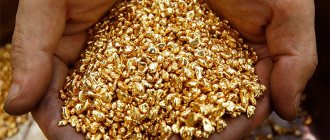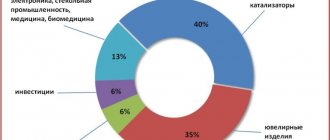Properties of platinoids
Platinum elements form the platinum group and belong to the transition metals. It includes:
- platinum;
- ruthenium;
- osmium;
- rhodium;
- palladium;
- iridium.
Platinum is part of the platinum group
Noble elements form compounds in natural conditions and are found in polymetallic ores; they are mined as a by-product in deposits of gold and silver. It was during the mining of placer gold that platinum was first discovered, which was initially identified as poor silver.
Depending on their density, platinoids are divided into 2 groups of elements: light and hard. Platinum belongs to the heavy group and requires high temperatures to melt. Compared to gold, it has higher hardness.
The precious material is quite malleable, stretches well, and can be processed well under pressure. The material can be rolled into a thin sheet, up to 0.0025 mm thick, and stretched into wire.
Platinum is the most chemically stable element, reacting only with small amounts of substances. When exposed to air with strong heating, it does not oxidize, and when cooled, it retains its original color.
Platinum belongs to the trace elements. It is usually found in combination with gold, in combination with the following ore minerals:
- iron;
- nickel;
- copper;
- lead.
The chemical element does not interact with individual acids, but dissolves in a mixture of concentrated acids. The metal interacts with potassium cyanide and alkaline compounds in the liquid state.
Caring for platinum jewelry
Jewelry care includes:
- cleaning by a professional (especially if the jewelry contains precious stones);
- checking for good fixation of stones in the product;
- unlike you, jewelry does not benefit from cosmetics and household chemicals;
- inspect the jewelry for cracks, scratches, or chips. If you find damage, run to the jeweler.
Store jewelry in separate cases, boxes, bags. This way, products made from different metals and stones (with different hardnesses) will not scratch one another.
Platinum image of Lenin on the Order of Lenin.
Wash earrings and rings with a neutral soap solution using a soft brush. Place the chains in a glass, fill with soapy water and swirl the contents.
Then rinse the product under running water and dry.
Density indicator
The density of a substance, calculated experimentally under normal conditions, is the ratio of the mass of a substance to its volume. The indicator is measured in g/cm³.
The practical use of this parameter allows you to make arithmetic calculations of the weight and composition of the material. To determine the number of alloy components in a volume, the specific gravity indicator is often used.
Platinum, whose density under normal conditions is 21.09–21.45 g/cm³, is a refractory metal. The melting point is 1773.5°C, the boiling point is 3825°C. The hardness of the metal on the Mohs scale corresponds to 4–4.5.
The density of a substance determines the weight and composition of the metal
To increase the density of the metal, alloys based on it are formed with other metal components:
- birth;
- iridium;
- ruthenium.
Materials with new properties are highly resistant to environmental temperatures and chemical reagents.
Being in nature
Isotopes
Natural platinum occurs as a mixture of six isotopes: 190Pt (0.014%), 192Pt (0.782%), 194Pt (32.967%), 195Pt (33.832%), 196Pt (25.242%), 198Pt (7.163%). One of them is weakly radioactive (190Pt, alpha decay in 186Os, half-life 6.5⋅1011 years). The existence of very weak radioactivity of two more natural isotopes of platinum is predicted: the alpha decay 192Pt→188Os and the double beta decay 198Pt→198Hg, however, these decays have not yet been experimentally recorded; it has only been established that the half-lives exceed 4.7×1016 years and 3.2×1014 years, respectively.
Place of Birth
Platinum nugget, Conder deposit
Platinum is one of the rarest metals: its average content in the earth's crust (clarke) is 5⋅10−7% by mass. Even the so-called native platinum is an alloy containing from 75 to 92 percent platinum, up to 20 percent iron, as well as iridium, palladium, rhodium, osmium, and less often copper and nickel.
The bulk of platinum deposits (more than 90%) are located in the subsoil of five countries. These countries include South Africa (Bushveld complex), USA, Russia, Zimbabwe, China.
In Russia, the main deposits of platinum group metals are: Oktyabrskoye, Talnakhskoye and Norilsk-1 sulfide-copper-nickel in the Krasnoyarsk Territory in the Norilsk region (more than 99% of explored and more than 94% of estimated Russian reserves), Fedorova Tundra (Bolshoi Ikhtegipakhk site) sulfide- copper-nickel in the Murmansk region, as well as alluvial deposits Konder in the Khabarovsk Territory, Levtyrinyvayam in the Kamchatka Territory, the Lobva and Vyisko-Isovskoye rivers in the Sverdlovsk Region. The largest platinum nugget found in Russia is the “Ural Giant” weighing 7860.5 g, discovered in 1904 at the Isovsky mine; currently stored in the Diamond Fund.
Industries using alloys
Platinum has a wide range of applications, but the main one is the jewelry industry
Platinum material is indispensable in the chemical and instrument-making industries. It is used in the aviation industry. But the main consumer of platinum and high-grade alloy based on it is the jewelry industry.
From the first quarter of the 19th century. the chemical element was used as an alloying component for the production of high quality steel. Before the invention of liquid crystal displays, screen coatings were made with a platinum compound.
In the 70s last century, platinum was used in automobile production. And currently, one of the main consumers is this industry, where the metal is used as a catalyst for cleaning exhaust gases from harmful compounds.
The device is a cylinder with an elliptical or circular cross-section, inside which there is a kind of honeycomb made of metal or ceramic, coated with a solution of platinum group metals.
In electrical engineering designed for low currents, alloys of the chemical element with gold and silver are used. The physical property of platinum, the ability to magnetize, is used in the manufacture of alloys of magnetic materials in the production of small-sized electrical appliances.
The material is used to make electrical parts and devices designed to operate in special conditions and aggressive environments:
- reactors;
- high-temperature furnaces (crucibles);
- thermocouples;
- for coating reactor surfaces;
- electric heaters;
- mirrors for laser technology;
- equipment for the production of optical glass.
Platinum-coated devices make it possible to obtain chemically pure preparations or products in the food industry.
Platinum group metals are used to make various laboratory instruments and equipment. They are used to produce utensils for melting alkalis, bowls for working with acids, boilers, and autoclaves.
Special needles are made from an alloy of gold, platinum and palladium; soldering on fountain pen nibs is made from it. Platinum is used in medicine as an element that slows down the development of disease.
History of platinum
Platinum was known even before our era. The ancient Egyptians used the mineral to create various jewelry. For some time it was common among the Incas. In the middle of the 6th century, Spanish conquistadors found this metal in South America, which reminded them of silver. They gave the new material an appropriate name. Translated from Spanish, platina means “little silver” or “little silver.” In those days, the new metal was little valued by people because of its refractoriness and high density. Platinum has been given names such as “immature gold” and “wrong silver.”
But later an interesting feature was found in the material: it turned out that it easily alloys with gold. Following this discovery, jewelers began mixing these metals to reduce the cost of producing jewelry and other accessories. The fake was practically impossible to distinguish from real gold. When this fraud was discovered, the import of platinum into Europe was banned for a certain period .
For a time, people believed that white gold and platinum were the same thing. This statement is incorrect, since the metals are different and similar only in appearance in color. The material became an independent chemical element only in the middle of the 18th century, when it was thoroughly studied. Platinum designation is Pt. The physical properties and operational features made it possible to use the metal in the manufacture of equipment and other purposes. Soon the price of the mineral increased sharply. Today platinum is considered one of the most expensive metals.
Platinum in monetary production and jewelry
Bank ingots are formed from chemically pure noble metal, which is allowed to contain natural impurities. They are intended for the following purposes:
- transactions at the interbank level;
- technical application;
- production of chemical compounds;
- production of semi-finished products and alloys for various industries.
Along with silver and gold, commemorative and commemorative coins are minted from platinum. It is used to make commemorative insignia for merit.
Platinum occupies a special place in jewelry. Every year the industry consumes about 50 tons of precious metal. The design of jewelry and the alloys of materials used to make them depend entirely on fashion trends.
Recently, the market has been filled with white gold jewelry, which in turn increases the demand for platinum and its group of metals. Finished products made from a gold alloy with alloy additives are eventually coated with a metal from the platinum group - palladium.
The cost of platinum in products is relatively high. But only the platinum base creates a unique play of diamonds in jewelry. Such jewelry is distinguished by its strength, durability, resistance to deformation and mechanical stress.
Earth and star maternity hospital platinum
The main platinum deposits are located in the countries:
- Zimbabwe;
- USA;
- SOUTH AFRICA;
- China;
- Russia.
This is approximately 90% of the world reserve (according to some analysts). Others give the same 90% of platinum in nature to one South African deposits. Such strange “analytics” show that the bowels of the Earth have been explored approximately.
There are small deposits in South America, Canada and a number of countries.
We mine platinum
About interesting and important mining sites of the “queen of metals”. Platinum is found in placers and ultramafic bedrock.
World platinum production (tonnes per year) over recent decades.
The process of formation of the noble metal occurred not only on Earth. Some of the asteroids that fell to Earth were filled with platinum group metals.
South Africa
The largest “basket” on earth with platinum and platinum group metals is located in South Africa. This is the Bushveld complex. It looks like a saucer with a diameter of about 370 km. Horizons (reefs), lenses, and platinum veins stretch from the edges of the saucer to the center. Their thickness ranges from 1 to 90 meters; some reefs are mined by open-pit mining.
¾ of all platinum is mined here.
Russia
We had the richest placer deposits in the Urals. Since 1828, the country has minted platinum coins in denominations of 3, 6 and 12 rubles. For coins, native metal was used, not purified from accompanying metals. The coins were minted for only 17 years, then they began to be withdrawn from circulation.
After 100 years, the Ural deposits were depleted.
Currently, silver mining is carried out in Taimyr, on the Kola Peninsula, in the Khabarovsk and Krasnoyarsk territories.
Canada
In central Ontario, nickel and palladium are mined, and platinum is a “prize” for miners. By the way, most likely, the platinum group metals here are of extraterrestrial origin. Once upon a time a huge meteorite fell here.
The Lac des Iles mine in western Ontario uses open-pit mining for platinum group metals. Recently, an underground mine was opened here, where the content of noble platinoids is higher.
USA
There are only two mines here, both in Montana. However, the ore is rich, the content of platinum group metals is about 20 grams per ton of ore.
In 2015, a small asteroid (less than a kilometer in diameter) flew close to Earth. It differs from the mass of other celestial bodies in its “filling”. The core of the celestial stone, as astronomers have found, consists of platinum, gold and other attractive metals. It's a shame we didn't catch it...
Receipt
Native platinum is mined at mines (see the article Noble Metals for more details); placer deposits of platinum are less rich, which are explored mainly by the method of spot testing.
The production of platinum in powder form began in 1805 by the English scientist W. H. Wollaston from South American ore.
Today, platinum is obtained from a concentrate of platinum metals. The concentrate is dissolved in aqua regia, after which ethanol and sugar syrup are added to remove excess HNO3. In this case, iridium and palladium are reduced to Ir3+ and Pd2+. The subsequent addition of ammonium chloride produces ammonium hexachloroplatinate (IV) (NH4)2PtCl6. The dried sediment is calcined at 800–1000 °C:
3(NH4)2[PtCl6] →T 2N2↑ + 2NH3↑ + 18HCl + 3Pt
The sponge platinum thus obtained is subjected to further purification by repeated dissolution in aqua regia, precipitation of (NH4)2PtCl6 and calcination of the residue. The purified sponge platinum is then melted into ingots. When reducing solutions of platinum salts by chemical or electrochemical methods, finely dispersed platinum is obtained - platinum black.


